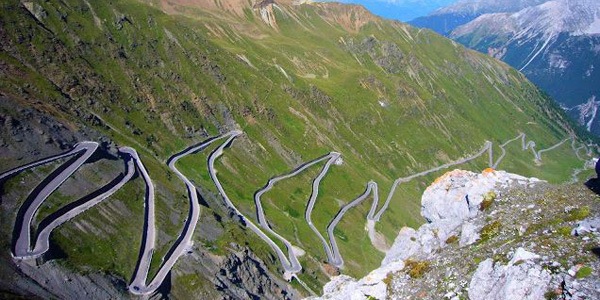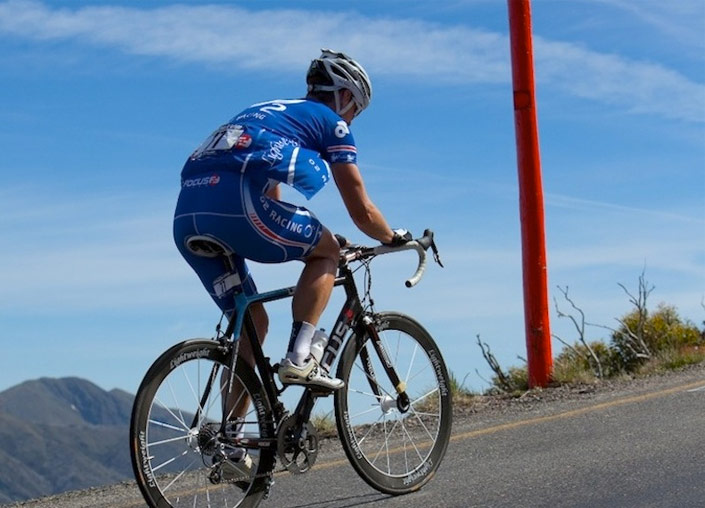Cycling is full of challenges, many of which you can overcome through practice and training. This is also true of the one challenge which remains unconquered by many cyclists - climbing: The ability to ride a bike up a hill, at a decent pace, (preferably keeping up with at least 50% of your riding group), and still remaining conscious at the top.
It is possible to become a better climber through technique as opposed to losing weight (which is the most common kneejerk response). But to understand HOW to climb better you first need to understand WHAT a climb actually is in a physiological way. Once you understand what a climb is (in numbers), you can train for it and learn to master it.
WHAT IS A CLIMB
Yes, a climb is a hill. Good answer! But to your body a climb is a set period of intense stress. Your body requires more oxygen and your muscles require more fuel. The only problem is your lungs aren't used to coping with such high oxygen demands and your body isn't used to processing fuels as quickly as it's needed. To sum this up, you're already dying before you reach halfway. In numbers, a climb is a period of time where your body must function at a higher level of stress.
CAN I IMPROVE?
We can all improve at climbing, but we must keep in mind our individual differences. Some of us weigh more than others, which means our engines have to work harder to get more weight up the hill. But we aren't focusing on that just yet because technique and training are far more important. The weight loss is actually a by-product of exercise, so you'll achieve that along the way anyway.
TECHNIQUE: Pedaling technique is extremely important in climbing and also quite hard to master.
Regardless of what you think you prefer, try this on your next climb. It is the only way to climb, so ignore excuses such as "I'm not built to pedal fast" and all the usual stuff. Pedal in a gear you can manage and when your cadence goes too high, change to a harder gear or slow down.
Pedal at 90-100rpm for the whole climb. If you can do this in a harder gear, do it. Whatever gear you're in, you must stick to this guideline. As you get better you can try a broader range from 90 - 115rpm. You'll need a cycling computer for this.
The technique itself is all about pedaling smoothly and efficiently. Imagine your pedal stroke as a clock face and refer to the table below;
- 11 o'clock to 1 o'clock: Dead Position (no power)
- 2 o'clock to 5 o'clock: Most powerful push phase of pedaling
- 5 o'clock to 9 o'clock: Pull phase, pulling backwards (NOT up).
These "times" above give you a basic idea of what a proper pedal stroke looks like. Remember to always keep your heels down, as this strengthens the push and pull phases of the pedal stroke. Also maintain that magic cadence number!
FITNESS
The other aspect of climbing better is fitness. Buy a heart rate monitor from your local bike shop and learn how to use it. For cycling we recommend a handlebar mounted unit. Figure out your maximum heart rate through calculations or recent exercise sessions. From here, figure out your 65%, 75%, 85% and 90% heart rate figures. Your body doesn't like working at any of these levels, unless of course you train it to cope! Most riders will cycle at 85% of their maximum heart rate uphill, while on the flat they'll only ever ride at 60-70% of their maximum heart rate. You see the problem? How can you expect your body to cope, when you never expose it to these higher stresses?
Wherever you find yourself riding, try sit on 85% of your maximum heart rate and check your speed. It's way faster than what you'd normally ride! It's also not sustainable, so do short efforts at higher heart rates. Try this on for size:
- 2 x 10 minute efforts @ 75% MHR (Maximum Heart Rate)
- 2 x 5 minute efforts @ 85% MHR
- 2 x 1 minute efforts @ 90% MHR or above
This is a pretty decent session, so don't be ashamed to alter it for your abilities or preferences.

RELATED ARTICLE:
Become a stronger, faster climber
Most people love cycling for the feeling of freedom it gives them. Soaring down a hill with nothing but a ribbon of tarmac in front of you - or even powering along passing others as if they're standing still. But then you hit a hill. Your riding becomes more..READ MORE
CLIMBING
The final tip for improving your climbing prowess is to climb more! On a climb, you get to put your newfound skills to use - namely your cadence workouts and heart rate zones. Start the climb at a gentle pace, gradually increasing your effort as you go. The number one focus should be your cadence. Maintain the cadence of 90-100rpm, and change gears accordingly to keep these numbers on target. If the climb is so steep that you can't maintain your cadence, then find one that allows you to manage better. You can ride up a wall on any other day, just not today...

TIP: Keep your head up, and back straight when you climb. Curling up in a ball over your handlebars is a physical concern, as well as a mental one. Nothing screams defeat more than a rider in the foetal position. Keep a calm, strong mind. To do this, you need a calm, strong posture.
Give these tips a crack on your next ride, and read some of our training articles to help you form your own training program. Once you've mastered the technical side of things, you can then work on increasing your physical strength through cross training (gym work). You can also consider your body and bike weight, only as a final option.
Happy climbing and keep that head up!





